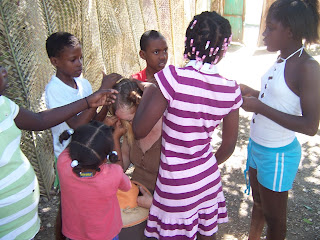I often take my sophomore math majors over to the Career Center at my college. I physically walk the class I'm teaching into the Career Center building -- I've learned that going the first time into a new place is the hardest, and that once the students have been there once, it's easier to go back.
In the same way, going to Haiti for the first time -- actually setting foot in the country -- was amazing. Beforehand, my husband and I were making jokes about letting our kids know where our wills are. Within a few hours of being in Mont Rouis, we were having serious conversations about retiring there.
 It's so hard to know where to begin describing a place so different from home. Here are three quick high-lights.
It's so hard to know where to begin describing a place so different from home. Here are three quick high-lights.
A bunch of the fun was hanging out with the kids in the orphanages, getting my hair "done". The village of Mont Rouis is home to an incredible number of orphanages -- we stayed at an missionary orphanage that specialized in taking care of kids with physical problems (club feet, missing limbs, and such). On one side of our mission, there was another orphanage with 40 babies; on the other side was the orphanage in these photos, run by a Haitian woman named Dina. She herself was an orphan, and she started up this place the day after the earthquake. That's where I got my hair pulled (I mean, brushed).
A second memory I'll cherish is hot banana soup. I always feel a twinge of guilt eating bananas in Pennsylvania, knowing how far they've travelled. But here, I could see the banana trees around me almost everywhere I looked. And I ate banana soup with gusto, knowing that for now it was a local treat.
The third take-away for me was related to the poverty and over-crowding that everyone who goes to Haiti is struck by. The main highway between Port Au Prince and Mont Rouis was torn up by the earthquake two years ago and still rubble for several miles. The land nearby is packed with shacks and tents, which are packed with people. I knew to expect all that (although seeing it in person was still a powerful experience). What surprised me most was the roadside stands, lining the highway -- or rather, what they did (and didn't sell).
As a veteran yard-saler, I'm at my element shopping al fresco, and I kept my eyes open for good Haitian memorabilia that I could bring home. But these stands basically sold imported plastic stuff. And imported clothes. And (with the exception of bananas and mangoes) imported food. There wasn't anything homemade, no wall-hangings, no colorful kitsch with "Haiti" painted on it in garish colors, no jewelry stands, no straw hats. There was nothing Haitian for tourists to buy, but there was also almost nothing Haitian for Haitians to buy.
There are so many different aspects of Haitian poverty, and I'm not sure why this last one had such an effect on me.
In the same way, going to Haiti for the first time -- actually setting foot in the country -- was amazing. Beforehand, my husband and I were making jokes about letting our kids know where our wills are. Within a few hours of being in Mont Rouis, we were having serious conversations about retiring there.
 It's so hard to know where to begin describing a place so different from home. Here are three quick high-lights.
It's so hard to know where to begin describing a place so different from home. Here are three quick high-lights.A bunch of the fun was hanging out with the kids in the orphanages, getting my hair "done". The village of Mont Rouis is home to an incredible number of orphanages -- we stayed at an missionary orphanage that specialized in taking care of kids with physical problems (club feet, missing limbs, and such). On one side of our mission, there was another orphanage with 40 babies; on the other side was the orphanage in these photos, run by a Haitian woman named Dina. She herself was an orphan, and she started up this place the day after the earthquake. That's where I got my hair pulled (I mean, brushed).
A second memory I'll cherish is hot banana soup. I always feel a twinge of guilt eating bananas in Pennsylvania, knowing how far they've travelled. But here, I could see the banana trees around me almost everywhere I looked. And I ate banana soup with gusto, knowing that for now it was a local treat.
The third take-away for me was related to the poverty and over-crowding that everyone who goes to Haiti is struck by. The main highway between Port Au Prince and Mont Rouis was torn up by the earthquake two years ago and still rubble for several miles. The land nearby is packed with shacks and tents, which are packed with people. I knew to expect all that (although seeing it in person was still a powerful experience). What surprised me most was the roadside stands, lining the highway -- or rather, what they did (and didn't sell).
As a veteran yard-saler, I'm at my element shopping al fresco, and I kept my eyes open for good Haitian memorabilia that I could bring home. But these stands basically sold imported plastic stuff. And imported clothes. And (with the exception of bananas and mangoes) imported food. There wasn't anything homemade, no wall-hangings, no colorful kitsch with "Haiti" painted on it in garish colors, no jewelry stands, no straw hats. There was nothing Haitian for tourists to buy, but there was also almost nothing Haitian for Haitians to buy.
There are so many different aspects of Haitian poverty, and I'm not sure why this last one had such an effect on me.



No comments:
Post a Comment